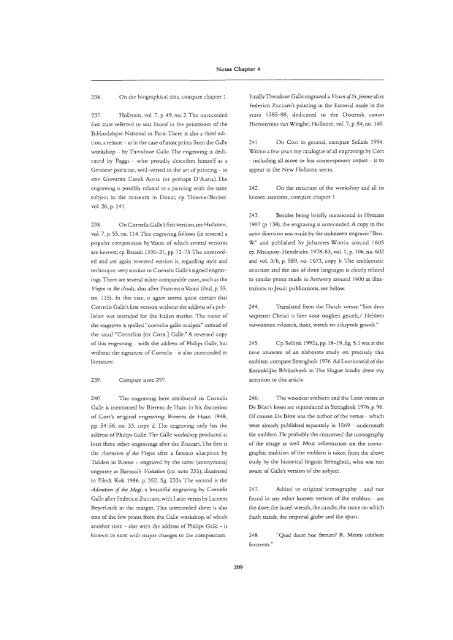manfred sellink philips galle - VU-DARE Home
manfred sellink philips galle - VU-DARE Home
manfred sellink philips galle - VU-DARE Home
Create successful ePaper yourself
Turn your PDF publications into a flip-book with our unique Google optimized e-Paper software.
236. On the biographical data, compare chapter 1,<br />
237. Hollstein, vol. 7, p, 49, no. 2.The unrecorded<br />
first state referred to was found in the printroom of the<br />
Bibliothèque National in Paris,There is also a third edi<br />
tion, a reissue - as In the case of most prints from die Galle<br />
workshop - by Theodoor Galle. The engraving is dedi<br />
cated by Paggi - who proudly describes himself as a<br />
Genoese patrician, well-versed in the art of painting - to<br />
one Giovanni Carol! Auria (or perhaps D 6<br />
Auria).The<br />
engraving is possibly related to a painting with the same<br />
subject In the museum in Douai; cp. Thleme/Becker,<br />
vol. 26, p, 141.<br />
238. On Cornells Galle s first version, see Hollstein,<br />
vol. 7, p. 55, no. 114.This engraving follows (in reverse) a<br />
popular composition byVanni of which several versions<br />
are known; cp. Brandi 1930-31, pp. 72 73.The unrecord<br />
ed and yet again reversed version is, regarding style and<br />
technique, very similar to Cornells Galle's signed engrav<br />
ings.There are several other comparable cases, such as the<br />
Virgin in the clouds, also after Francesco Vanni (ibid, p. 55,<br />
no. 115). In this case, it again seems quite certain mat<br />
Cornells Galle s first version without the address of a pub<br />
lisher was intended for the Italian market. The name of<br />
the engraver is spelled "'eornelio gallo sculpsit" instead of<br />
the usual "Cornelius [or Corn.] Galle." A reversed copy<br />
of this engraving - with the address of Philips Galle, but<br />
without the signature of Cornells - is also unrecorded in<br />
literature.<br />
239. Compare note 297.<br />
240. The engraving here attributed to Cornells<br />
Galle is mentioned by Blerens de Haan in his discussion<br />
of Cort s original engraving; Bierens de Haan 1948,<br />
pp. 54-56, no. 33, copy d. The engraving only has the<br />
address of Philips Galle, The Galle workshop produced at<br />
least three other engravings after the Zuccari.The first is<br />
the Ascension of the Virgin after a famous altarpiece by<br />
Taddeo in Rome - engraved by the same (anonymous)<br />
engraver as Barocci's Visitation (cp. note 235); illustrated<br />
in Filedt Kok 1986, p. 352, fig. 233a. The second is the<br />
Adoration of the Magi, a beautiful engraving by Cornells<br />
Galle after Federico Zuccaro, with Latin verses by Laurens<br />
Beyerlmck in the margin. This unrecorded sheet is also<br />
one of the few prints from the Galle workshop, of which<br />
another state - also with the address of Philips Galle - is<br />
known to exist with major changes to the composition.<br />
Notes Chapter 4<br />
209<br />
Finally Theodoor Galle engraved a Vision of St Jerome after<br />
Federico Zuccaro s painting in the Escorial made in the<br />
years 1585-88, dedicated to the Doornik canon<br />
Hieronymus van Winghe; Hollstein, vol. 7, p. 84, no. 140,<br />
241. On Cort In general, compare Sellink 1994,<br />
Within a few years my catalogue of all engravings by Cort<br />
- including all more or less contemporary copies - is to<br />
appear in the New Hollstein series.<br />
242. On the structure of the workshop and all its<br />
known assistants, compare chapter 1<br />
243. Besides being briefly mentioned In Hymans<br />
1907 (p. 138), the engraving is unrecorded. A copy In the<br />
same direction was made by the unknown engraver li<br />
Ben.<br />
W." and published by Johannes Wierix around 1605<br />
cp. Mauquoy-Hendrickx 1978-83, vol, 1, p. 106, no. 602<br />
and vol. 3/b, p, 589, no, 1673, copy b. The emblematic<br />
structure and the use of three languages is clearly related<br />
to similar prints made in Antwerp around 1600 as illus<br />
trations to Jesuit publications, see below,<br />
244. Translated from the Dutch verses: "Siet dees<br />
wapenen Christ! u hier voor ooghen gestelt,/ Hebben<br />
verwonnen tvleesch, doot, werelt en s'duyvels gewelt."<br />
245. Cp. Sellink 1992a, pp. 18-19, fig. 5.1 was at the<br />
time unaware of an elaborate study on precisely this<br />
emblem, compare Strengholt 1976. Ad Leerintveld of the<br />
Koninklijke Bibllotheek in The Hague kindly drew my<br />
attention to this article.<br />
246. The woodcut emblem and the Latin verses in<br />
De Beze's kones are reproduced in Strengholt 1976,p. 96.<br />
Of course, De Beze was the author of the verses - which<br />
were already published separately in 1569 - underneath<br />
the emblem. Fie probably the conceived the iconography<br />
of the image as well. Most information on the icono-<br />
graphic tradition of the emblem is taken from the above<br />
study by the historical linguist Strengholt, who was not<br />
aware of Galle s version of the subject.<br />
247. Added to original iconography - and not<br />
found in any other known version of the emblem - are<br />
the dove, the laurel wreath, the candle, the stone on which<br />
Faith stands, the imperial globe and the spurs,<br />
248. "Quid docet hoc frenum? R. Mentis cohibere<br />
furorem."

















